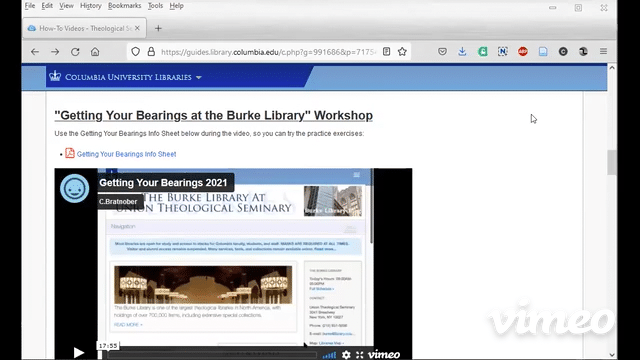I’m not the only librarian who added “asynchronous learning” to my vocabulary in the last two years – most educators became familiar with this phrase during the early months of the ongoing COVID-19 pandemic, when classrooms were shut down. Librarians were part of this shift too. How could we continue teaching library users about CLIO and databases and Zotero? Thus sparked my journey into the world of video-editing for the creation of instructional Library videos.
The shut-down necessitated remote-learning access with classes on Zoom. However, the pandemic also posed several barriers to real-time online learning access: students were spread across far-flung time zones, some students had limited access to the internet, and some shared devices and learning spaces with family and roommates.

The Zoom environment did offer one a unique opportunity for instructors: hosts can easily hit “Record” to save the contents of a Screen-Share as a video file. Demand for recorded versions of workshops and classes skyrocketed. By April of 2020, students regularly expected to be able to watch sessions on their own time (“asynchronously”). Within the Columbia University Libraries, many of us had begun experimenting with the Zoom-recording feature. I joined a group of Librarians charged with creating video-length versions of materials typically taught to undergraduates, and I began recording most of my workshops for asynchronous sharing too.
One major drawback to videos is viewer attention spans. Watching a video of a 90-minute class, alone, without participation or interaction, can be a draining experience (no matter how engaging the quality of the instruction). Typically it behooves educators to think critically about what materials to include. It often helps to keep the length of video modules as brief as possible, and to find ways to include accompanying activities and hands-on learning materials. With iMovie, a free video-editing app that came with my personal MacBook laptop (my primary work computer while I was working remotely), I could transform lengthy workshops into brief video modules. Having some experience with iMovie – from high school, college, and a few creative projects – this quickly became one of my favorite areas of my work-from-home routine.

Editing the videos down to short modules, I cut out the repetitions, pauses, and “ums” from my own voice, to make statements brief and crisp. To cut time, I also trimmed-out sections of students doing activities independently. (Viewers can always pause to try exercises; they don’t need ten minutes of silence.) By “detaching” the audio from the visual clips, one can also superimpose and add voice-over to different visuals such as screenshots, images of worksheets, etc., to enhance the visual presentation. One can add transition effects, but these can come across as old-fashioned and cheesy, so I try to keep these minimal. Lastly, I made it a practice to erase students’ questions, voices, and faces, to protect their privacy. I observed very few discussions of the repercussions of recording so much educational content early in the pandemic among my educator colleagues. It may become more of an issue later on (who knows?) but for privacy – as well as for brevity – I chose to cut students wherever possible.
With iMovie I was able to transform 90-minute recordings into short 15-minute webinar-esque videos. I uploaded them to Vimeo to have shareable links. Then I created a “How-To Videos” tab in the Theological Seminary Studies Library Guide to display this library of tutorials. (LibApps, our tool for making LibGuides, has a user-friendly tool to embed Vimeo videos as widgets. Super handy!) Now I can send this single link when someone emails the Burke saying they can’t attend a live workshop; there might be a video of a previous session they can watch at any time. There’s a whole library of workshops on topics ranging from “Getting Your Bearings” to “Intro to Zotero.” Most of these videos come with accompanying one-page PDF handouts, with links and exercises to follow along from home, to add a “hands-on” element to the learning experience. I even created some documentation for my librarian colleagues, and led a few workshops to teach others how to create and share instructional videos on their own.

One of my goals for the summer is to add closed-captions to my videos. Columbia’s office of Disability Services will add closed-captions if the video-creator provides a transcript, so the first step will be for me to transcribe the videos myself, by hand (which will be a whole other story). Always handy to be able to use one’s early-career skills again in surprising ways! Hopefully these videos will make instructional content more accessible to Burke and Columbia University Libraries users worldwide. -CB